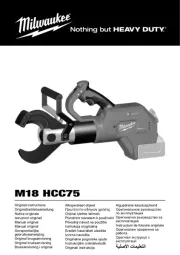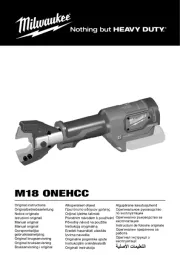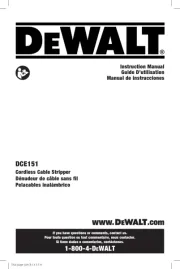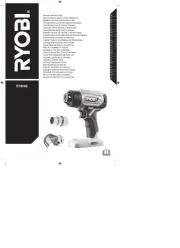Milwaukee M12 Force Logic 2473-20 Handleiding
Milwaukee
Kabelstripper
M12 Force Logic 2473-20
Bekijk gratis de handleiding van Milwaukee M12 Force Logic 2473-20 (11 pagina’s), behorend tot de categorie Kabelstripper. Deze gids werd als nuttig beoordeeld door 92 mensen en kreeg gemiddeld 4.5 sterren uit 46.5 reviews. Heb je een vraag over Milwaukee M12 Force Logic 2473-20 of wil je andere gebruikers van dit product iets vragen? Stel een vraag
Pagina 1/11

OPERATOR'S MANUAL
MANUEL de L'UTILISATEUR
MANUAL del OPERADOR
TO REDUCE THE RISK OF INJURY, USER MUST READ AND UNDERSTAND OPERATOR'S
MANUAL.
AFIN DE RÉDUIRE LE RISQUE DE BLESSURES, L'UTILISATEUR DOIT LIRE ET BIEN
COMPRENDRE LE MANUEL DE L'UTILISATEUR.
PARA REDUCIR EL RIESGO DE LESIONES, EL USUARIO DEBE LEER Y ENTENDER EL
MANUAL DEL OPERADOR.
Cat. No.
No de cat.
2473-20
M12™ PRESS TOOL
OUTIL DE PRESSAGE M12™
HERRAMIENTA DE PRENSA M12™

23
PERSONAL SAFETY
GENERAL POWER TOOL SAFETY WARNINGS
WORK AREA SAFETY
ELECTRICAL SAFETY
• Keep work area clean and well lit. Cluttered or
dark areas invite accidents.
• Do not operate power tools in explosive atmo-
spheres, such as in the presence of fl ammable
liquids, gases or dust. Power tools create sparks
which may ignite the dust or fumes.
• Keep children and bystanders away while
operating a power tool. Distractions can cause
you to lose control.
• Power tool plugs must match the outlet. Never
modify the plug in any way. Do not use any
adapter plugs with earthed (grounded) power
tools. Unmodifi ed plugs and matching outlets will
reduce risk of electric shock.
• Avoid body contact with earthed or grounded
surfaces such as pipes, radiators, ranges and
refrigerators. There is an increased risk of electric
shock if your body is earthed or grounded.
• Do not expose power tools to rain or wet condi-
tions. Water entering a power tool will increase
the risk of electric shock.
• Do not abuse the cord. Never use the cord for
carrying, pulling or unplugging the power tool.
Keep cord away from heat, oil, sharp edges
or moving parts. Damaged or entangled cords
increase the risk of electric shock.
• When operating a power tool outdoors, use an
extension cord suitable for outdoor use. Use
of a cord suitable for outdoor use reduces the risk
of electric shock.
• If operating a power tool in a damp location
is unavoidable, use a residual current device
(RCD) protected supply. Use of an RCD reduces
the risk of electric shock.
• Do not overreach. Keep proper footing and
balance at all times. This enables better control
of the power tool in unexpected situations.
• Dress properly. Do not wear loose clothing or
jewellery. Keep your hair, clothing and gloves
away from moving parts. Loose clothes, jewel-
lery or long hair can be caught in moving parts.
• If devices are provided for the connection of
dust extraction and collection facilities, ensure
these are connected and properly used. Use of
dust collection can reduce dust-related hazards.
WARNING READ ALL SAFETY WARNINGS AND ALL INSTRUCTIONS.
Failure to follow the warnings and instructions may result in electric shock, fi re and/or
serious injury. Save all warnings and instructions for future reference.
The term "power tool" in the warnings refers to your mains-operated (corded) power tool or
battery-operated (cordless) power tool.
POWER TOOL USE AND CARE
• Do not force the power tool. Use the correct
power tool for your application. The correct
power tool will do the job better and safer at the
rate for which it was designed.
• Do not use the power tool if the switch does not
turn it on and o. Any power tool that cannot be
controlled with the switch is dangerous and must
be repaired.
• Disconnect the plug from the power source
and/or the battery pack from the power tool
before making any adjustments, changing
accessories, or storing power tools. Such
preventive safety measures reduce the risk of
starting the power tool accidentally.
• Store idle power tools out of the reach of chil-
dren and do not allow persons unfamiliar with
the power tool or these instructions to operate
the power tool. Power tools are dangerous in the
hands of untrained users.
• Maintain power tools. Check for misalignment
or binding of moving parts, breakage of parts
and any other condition that may affect the
power tool’s operation. If damaged, have the
power tool repaired before use. Many accidents
are caused by poorly maintained power tools.
• Keep cutting tools sharp and clean. Properly
maintained cutting tools with sharp cutting edges
are less likely to bind and are easier to control.
• Use the power tool, accessories and tool bits
etc., in accordance with these instructions,
taking into account the working conditions and
the work to be performed. Use of the power tool
for operations dierent from those intended could
result in a hazardous situation.
• Stay alert, watch what you are doing and use
common sense when operating a power tool. Do
not use a power tool while you are tired or under
the infl uence of drugs, alcohol or medication. A
moment of inattention while operating power tools
may result in serious personal injury.
• Use personal protective equipment. Always
wear eye protection. Protective equipment such
as dust mask, non-skid safety shoes, hard hat, or
hearing protection used for appropriate conditions
will reduce personal injuries.
• Prevent unintentional starting. Ensure the
switch is in the o-position before connecting
to power source and/or battery pack, picking
up or carrying the tool. Carrying power tools with
your fi nger on the switch or energising power tools
that have the switch on invites accidents.
• Remove any adjusting key or wrench before
turning the power tool on. A wrench or a key left
attached to a rotating part of the power tool may
result in personal injury.
• Recharge only with the charger specifi ed by
the manufacturer. A charger that is suitable for
one type of battery pack may create a risk of fi re
when used with another battery pack.
• Use power tools only with specifi cally desig-
nated battery packs. Use of any other battery
packs may create a risk of injury and fi re.
BATTERY TOOL USE AND CARE

45
Volts
Direct Current
R
C US
Canadian Standards Association,
United States and Canada
Always wear eye protection.
• Use tool only as directed. Only trained person-
nel should operate tool.
• Do not use tool without crimping head in-
stalled. Fingers could be crushed.
• Keep hands away from crimping head while
tool is in use. Fingers could be crushed.
• To reduce the risk of injury, wear safety
goggles or glasses with side shields. Inspect
and discard workpieces with cracks or wear
before use. Materials may crack or shatter.
Cat. No. Volts DC Watts Nominal Force Compression Range
2473-20 12 240 5400 lbs < Ø 1-1/4" (32 mm)
FUNCTIONAL DESCRIPTION SYMBOLOGY
SPECIFICATIONS
SPECIFIC SAFETY RULES
• When battery pack is not in use, keep it away
from other metal objects like paper clips,
coins, keys, nails, screws, or other small metal
objects that can make a connection from one
terminal to another. Shorting the battery termi-
nals together may cause burns or a fi re.
• Under abusive conditions, liquid may be eject-
ed from the battery; avoid contact. If contact
accidentally occurs, fl ush with water. If liquid
contacts eyes, additionally seek medical help.
Liquid ejected from the battery may cause irritation
or burns.
SERVICE
• Have your power tool serviced by a qualifi ed
repair person using only identical replacement
parts. This will ensure that the safety of the power
tool is maintained.
1. Start button
2. Fuel gauge
3. Red LED
4. Green LED
• Use tool only with MILWAUKEE crimping heads
and to press-fi t pipes and fi ttings for which
they are designed. Other uses may cause injury
or damage to the tool, accessories, and pipes.
Leaking may result.
• Only use MILWAUKEE crimping head with a
compression range rated for this tool.
• Maintain labels and nameplates. These carry
important information. If unreadable or missing,
contact a MILWAUKEE service facility for a free
replacement.
• WARNING: Some dust created by power sanding,
sawing, grinding, drilling, and other construction
activities contains chemicals known to cause
cancer, birth defects or other reproductive harm.
Some examples of these chemicals are:
• lead from lead-based paint
• crystalline silica from bricks and cement and other
masonry products, and
• arsenic and chromium from chemically-treated
lumber.
Your risk from these exposures varies, depending
on how often you do this type of work. To reduce
your exposure to these chemicals: work in a well
ventilated area, and work with approved safety
equipment, such as those dust masks that are
specially designed to fi lter out microscopic particles.
5. Crimping head
6. Retaining pin
7. Release button
1
2
6
5
3
4
7
Fuel Gauge
To determine the amount of charge left in the bat-
tery, press and release the start button. The Fuel
Gauge will light up. To signal the end of charge,
one light on the fuel gauge will fl ash.
Pressing
• Before beginning a press, inspect the jaw as-
sembly for cracks or other damage. Do not use
a damaged jaw assembly. Return damaged jaw
assembly to a MILWAUKEE service facility.
• Before beginning a press, check the fuel gauge to
determine whether the battery charge is suffi cient
to complete the pressing operation.
• The tool will turn off automatically after 30 minutes
of no use.
• Inspect and discard workpieces with cracks or
wear before use. Materials may crack or shatter.
1. Turn the tool ON by quickly pressing and releas-
ing the start button.
2. Open the jaws
and place around
the fi tting.
3. Hold tool securely.
Press and hold
the start button.
The green LED
will go out.
4. T h e aut o ma tic
press cycle be-
gins. Release the
start button and
continue to hold
the tool securely.
5. When the press
cycle is complete
the tool will switch
o and the green
LED will light.
6. To c a n c e l t h e
automatic press
cycle, press and
hold the release button. Hold tool securely until
jaws open and the tool turns o.
7. If the tool is in use for 30 minutes continuously
(e.g., on a manufacturing fi xture), allow the tool
to cool down for at least 15 minutes before
continuing. Under normal use (e.g., plumbing/
mechanical) press freely and pay attention to the
LED indicators (see "Troubleshooting").
8. If the red LED lights, press the start button.
If the tool does not run, return the tool to a
MILWAUKEE service facility for repairs.
9. If the red and green LEDs fl ash alternately,
the tool must be serviced by a MILWAUKEE
service facility.
Inserting/Removing the Battery
To remove the battery, push in the release buttons
and pull the battery pack away from the tool.
To insert the battery, slide the pack into the body
of the tool. Make sure it latches securely into place.
Inserting/Removing/Positioning the
Crimping Head
1. Rotate the retaining pin 180° (1), then pull out (2).
2. Insert the crimping head.
3. Push in the retaining pin (1), then rotate 180° (2).
CAUTION To avoid damage to the tool, do
not operate the tool without the retaing pin
fully inserted and locked into position. Dam-
age to the cylinder may occur.
4. Rotate the head to the desired angle.
2
1
1
2
OPERATION
WARNING Always remove battery
pack before changing or removing acces-
sories. Only use accessories specifically
recommended for this tool. Others may be
hazardous.
WARNING To reduce the risk of injury,
wear safety goggles or glasses with side
shields.
ASSEMBLY
WARNING Recharge only with the
charger specifi ed for the battery. For specifi c
charging instructions, read the operator’s
manual supplied with your charger and battery.
WARNING Always remove battery
pack before changing or removing acces-
sories. Only use accessories specifically
recommended for this tool. Others may be
hazardous.
Product specificaties
| Merk: | Milwaukee |
| Categorie: | Kabelstripper |
| Model: | M12 Force Logic 2473-20 |
Heb je hulp nodig?
Als je hulp nodig hebt met Milwaukee M12 Force Logic 2473-20 stel dan hieronder een vraag en andere gebruikers zullen je antwoorden
Handleiding Kabelstripper Milwaukee

19 November 2024

16 November 2024

16 November 2024

10 Juni 2024

6 Juni 2023

3 Juni 2023

8 Mei 2023

6 April 2023

3 April 2023

2 April 2023
Handleiding Kabelstripper
Nieuwste handleidingen voor Kabelstripper

27 Augustus 2024

14 Augustus 2024

26 Juli 2023

26 Juli 2023

5 Juli 2023

4 Juli 2023

28 Juni 2023

28 Juni 2023

27 Juni 2023

16 April 2023